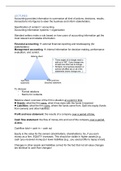Samenvatting
Summary Financial Accounting VU IBA
- Instelling
- Vrije Universiteit Amsterdam (VU)
Summary containing all the relevant theory discussed during the course Accounting given in the first year of International Business Administration at the Vrije Universiteit Amsterdam. By learning this summary I personally passed the final exam.
[Meer zien]




